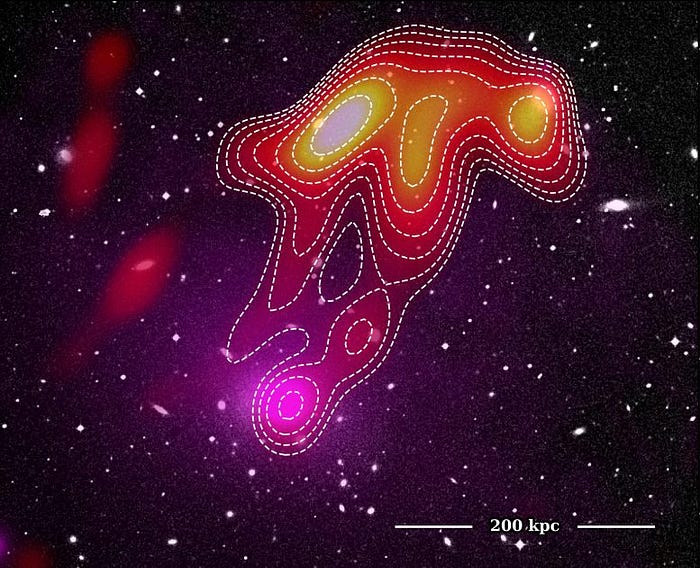Unveiling the Mystery of the Cosmic Jellyfish: USS Jellyfish
Written on
Chapter 1: Discovering the Cosmic Jellyfish
The universe is full of astonishing discoveries, and astronomers are continually unveiling strange phenomena as they explore the vastness of space. A recent remarkable find was made by an Australian-Italian research team utilizing the Murchison Widefield Array (MWA) telescope located in Western Australia. This team stumbled upon a jellyfish-like formation while investigating a galaxy cluster known as Abell 2877, situated approximately 340 million light-years from Earth.
The researchers dedicated 12 hours to observing this galaxy cluster across five different radio frequencies, ranging from 87.5 to 215.5 megahertz. They named this extraordinary cosmic formation "USS Jellyfish." Stretching over a million light-years, this colossal entity, composed of aging plasma, appears unlike any other structures previously documented. When viewed from Earth, it bears a striking resemblance to a jellyfish.
In 2017, Terrance Hodgson, the lead author of the study, first detected this unusual cosmic structure while examining various radio sources using the same MWA telescope. Initially, the peculiar observation led the researchers to think it might be an anomaly in their data. To confirm their findings, Hodgson and his team revisited the blob in 2018, employing the Australia Telescope Compact Array and the enhanced MWA Phase 2 survey.
"This radio jellyfish holds a world record of sorts. While it's bright at regular FM radio frequencies, at 200 MHz the emission all but disappears. No other extragalactic emission like this has been observed to disappear anywhere near so rapidly."
~ Terrance Hodgson, Lead Author
After several months of follow-up research, the astronomers produced high-resolution images of the "space jellyfish." Their latest observations affirmed that the USS Jellyfish is most luminous at a narrow band of low frequencies below 200 MHz, yet it remains undetectable by most radio telescopes that capture higher frequencies.
As the researchers explained, increasing the frequency results in a dramatic decrease in the brightness of this entity. Although they anticipated garnering some insights from the low-frequency radio telescopes like the MWA, the USS Jellyfish remains an enigmatic phenomenon, displaying the steepest spectrum ever recorded at these low frequencies.
The scientists propose a possible explanation, suggesting that this may be a "radio phoenix," where the remnants of an older structure are reactivated by a new energizing event. While smaller radio phoenixes have been observed in the past, the USS Jellyfish is being labeled as the first instance of a "polyphoenix," highlighting its vast and layered nature.
For the time being, Hodgson and his team plan to conduct follow-up observations utilizing X-ray technology to identify any remnants of an energizing event. Any comprehensive explanation may take several years to emerge, particularly with the anticipated launch of the Square Kilometre Array (SKA), a massive radio telescope set to span continents, expected to come online in the 2030s.
Complete research findings have been published in The Astrophysical Journal. Stay updated with essential content—join my mailing list.
Section 1.1: Cosmic Wonders in Video
To further explore the mysteries of the cosmos, check out the following videos:
The first video titled "What Are Jellyfish Galaxies?" delves into the captivating nature of these cosmic formations.
The second video, "What's that in the sky? It's called a space jellyfish," provides additional insights into this peculiar phenomenon.
Subsection 1.1.1: Visual Representation
